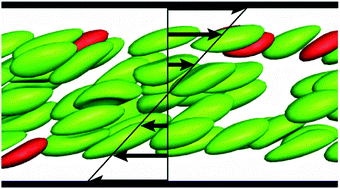Shape-mediated margination and demargination in flowing multicomponent suspensions of deformable capsules
Abstract
We present detailed simulations and theory for flow-induced segregation in suspensions of deformable fluid-filled capsules with different shapes during simple shear flow in a planar slit. This system is an idealized model for transport for blood cells and/or drug carriers in the microcirculation or in microfluidic devices. For the simulations, an accelerated implementation of the boundary integral method was employed. We studied the binary mixtures of spherical and ellipsoidal capsules, varying the aspect ratio κ of the ellipsoid while keeping constant either (a) equatorial radius or (b) volume. Effects of a variety of parameters was studied, including κ, volume fraction and number fraction of the spherical capsules in the mixture. In suspensions where the ellipsoids have the same equatorial radius as the spheres, capsules with lower κ marginate. In suspension where the ellipsoids have the same volume as the spheres, ellipsoidal (both oblate and prolate) capsules are seen to demarginate in a mixture of primarily spherical capsules. To understand these results, a mechanistic framework based on the competition between wall-induced migration and shear-induced collisions is presented. A simplified drift-diffusion theory based on this framework shows excellent qualitative agreement with simulation results.



 Please wait while we load your content...
Please wait while we load your content...